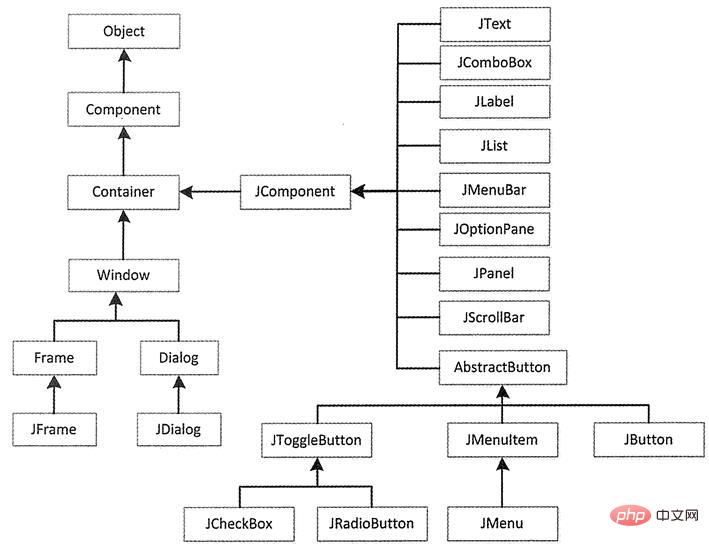What is swing in java

Swing is a development toolkit (GUI toolkit) for developing Java application user interfaces. It is part of the JAVA basic class; it includes graphical user interface (GUI) devices , such as: text boxes, buttons, split panes and tables.
Swing is based on the Abstract Window Toolkit (AWT) so that cross-platform applications can use any pluggable appearance style. Swing developers can take advantage of Swing's rich, flexible features and modular components to create elegant user interfaces with only a small amount of code. All packages in the toolkit are named with swing, such as javax.swing,javax.swing.event.
Swing provides many better screen display elements than AWT. They are written in pure Java, so they can run cross-platform like Java itself, unlike AWT. They are part of JFC. They support replaceable panels and themes (default specific themes for various operating systems), but do not actually use the devices provided by the native platform, but only superficially imitate them. This means you can use any panel supported by JAVA on any platform. The disadvantage of lightweight components is that they execute slowly, but the advantage is that they can adopt uniform behavior on all platforms.
Swing class library structure
Swing components all adopt the MVC (Model-View-Controller, model-view-controller) design to realize the display of GUI components. The separation of logic and data logic allows programmers to customize Render to change the display appearance of GUI components to provide more flexibility.
Swing is built around the JComponent component, which extends from the AWT container class. The Swing organizational structure is shown in the figure.

As you can see from the above figure, Swing components all start with J except for the AbstmctButton class. The Swing container component directly inherits the container component class in the AWT class library, and most other components inherit the JComponet component. Components can be divided into container components and non-container components. Container components include JFmme and JDialog. Among them, JComponent defines lightweight components of non-container classes (JBntton, JPanel, JMenu, etc.).
The above is the detailed content of What is swing in java. For more information, please follow other related articles on the PHP Chinese website!

Hot AI Tools

Undresser.AI Undress
AI-powered app for creating realistic nude photos

AI Clothes Remover
Online AI tool for removing clothes from photos.

Undress AI Tool
Undress images for free

Clothoff.io
AI clothes remover

AI Hentai Generator
Generate AI Hentai for free.

Hot Article

Hot Tools

Notepad++7.3.1
Easy-to-use and free code editor

SublimeText3 Chinese version
Chinese version, very easy to use

Zend Studio 13.0.1
Powerful PHP integrated development environment

Dreamweaver CS6
Visual web development tools

SublimeText3 Mac version
God-level code editing software (SublimeText3)

Hot Topics
 Square Root in Java
Aug 30, 2024 pm 04:26 PM
Square Root in Java
Aug 30, 2024 pm 04:26 PM
Guide to Square Root in Java. Here we discuss how Square Root works in Java with example and its code implementation respectively.
 Perfect Number in Java
Aug 30, 2024 pm 04:28 PM
Perfect Number in Java
Aug 30, 2024 pm 04:28 PM
Guide to Perfect Number in Java. Here we discuss the Definition, How to check Perfect number in Java?, examples with code implementation.
 Random Number Generator in Java
Aug 30, 2024 pm 04:27 PM
Random Number Generator in Java
Aug 30, 2024 pm 04:27 PM
Guide to Random Number Generator in Java. Here we discuss Functions in Java with examples and two different Generators with ther examples.
 Armstrong Number in Java
Aug 30, 2024 pm 04:26 PM
Armstrong Number in Java
Aug 30, 2024 pm 04:26 PM
Guide to the Armstrong Number in Java. Here we discuss an introduction to Armstrong's number in java along with some of the code.
 Weka in Java
Aug 30, 2024 pm 04:28 PM
Weka in Java
Aug 30, 2024 pm 04:28 PM
Guide to Weka in Java. Here we discuss the Introduction, how to use weka java, the type of platform, and advantages with examples.
 Smith Number in Java
Aug 30, 2024 pm 04:28 PM
Smith Number in Java
Aug 30, 2024 pm 04:28 PM
Guide to Smith Number in Java. Here we discuss the Definition, How to check smith number in Java? example with code implementation.
 Java Spring Interview Questions
Aug 30, 2024 pm 04:29 PM
Java Spring Interview Questions
Aug 30, 2024 pm 04:29 PM
In this article, we have kept the most asked Java Spring Interview Questions with their detailed answers. So that you can crack the interview.
 Break or return from Java 8 stream forEach?
Feb 07, 2025 pm 12:09 PM
Break or return from Java 8 stream forEach?
Feb 07, 2025 pm 12:09 PM
Java 8 introduces the Stream API, providing a powerful and expressive way to process data collections. However, a common question when using Stream is: How to break or return from a forEach operation? Traditional loops allow for early interruption or return, but Stream's forEach method does not directly support this method. This article will explain the reasons and explore alternative methods for implementing premature termination in Stream processing systems. Further reading: Java Stream API improvements Understand Stream forEach The forEach method is a terminal operation that performs one operation on each element in the Stream. Its design intention is






